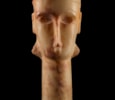Votive Head Of A Woman
With an elongated, slender neck, a finely carved straight nose above a small mouth, grooved arched eyebrows and semi-circular ears in relief. The eyes are deeply carved for inlay. In characteristic yellow veined alabaster. The top has been cut flat and left rough, possibly to fit into a niche or recess. The triangular protuberances on either side of the neck represents bunched hair. This elegant head is reputed to have come from Hayd ibn 'Aqil, the necropolis of ancient Timna’, located a little to the north of the city. Timna’ was the capital of the ancient kingdom of Qataban, one of the richest kingdoms of ancient South Arabia, whose wealth derived largely from its strategic position along the Incense Route, as a trading point for merchants dealing in spices and, most importantly, frankincense, myrrh and cinnamon. According to the Roman author Pliny the Elder, who died in 79 A.D., Timna’ was a bustling city with some sixty-five temples. Excavations suggest a major fire forced its inhabitants to abandon the city sometime in the first century A.D. Such heads most likely decorated tombs, memorialising the individuals within, and would have belonged to an elite individual.
L’Œil, n°422, January 1990, pg.45. Ancient Sculpture and Works of Art Part I, Sotheby’s, London, 7th December 2021, Lot 1 (front cover)
David Aaron Ltd, 2023, No. 27.
Reputedly from Beihan, probably from Hayd ibn ‘Aqil, the necropolis of ancient Timna’.
Antonin Besse (1927-2016) and Christiane Besse (1928-2021), Aden and Paris, acquired in Yemen in the 1960s, collection number CB47 (recorded for export to France by the Department of Antiquities, Aden State, in May 1967).
Thence by descent.
Sold at: Ancient Sculpture and Works of Art Part I, Sotheby’s, London, 7th December 2021, Lot 1 (front cover)
Acquired from the above sale.
ALR: S00227251.
Antonin ‘Tony’ Besse II (1927–2016) was the sixth child and third son of the prominent French-born, Adenbased businessman Antonin Besse and his second wife Hildra Crowther. His father, a passionate Anglophile and prominent anti-Nazi founded St. Anthony’s College, Oxford, was forever immortalised as Mr Baldwin in Evelyn Waugh’s novel ‘Scoop’, and was described by the travel writer and explorer Freya Stark as “a merchant in the style of the Arabian Nights”. He was a shrewd businessman who by 1923 controlled 72 per cent of the Red Sea oil trade, and in 1936 installed the first diesel engines in Arab dhows, building up a fleet that could operate in all weathers carrying mutton from Berbera to Aden.
Born in the south of France, Tony Besse II spent his youth running errands for the French resistance in the Alpilles. His formal education ended after he stood up in assembly and shouted at the headmaster, a Vichy supporter. He was interrogated , but the Italian officer had been in Somalia, knew of his father, and cried, “You have your life in front of you. Run!”
Spells as a resistance fighter and, post-war, working the black market followed. At one point, after an argument with his father in Aden, he jumped on one of the company’s ships to New York and worked for a spell as an unlicensed taxi driver. After his father’s death in 1951 he took over the running of the family business, aged 24. During the 60s the couple was actively involved in the excavations at Palmyra and in Libya. Besse ran the family company until it was lost to Communist control, as their interests were nationalised in 1969. He eventually made a home in Paris, but his heart remained in the war-torn Middle East.
In later life he was persuaded by Kurt Hahn, his father’s great friend and the founder of Gordonstoun, to help fund the founding of what is now UWC Atlantic, buying St Donat’s Castle, a 12th-century castle in South Wales once owned by William Randolph Hearst.
Christiane Besse (1928–2021) was born in Senegal, the daughter of a soldier, and grew up in Morocco before moving to France to study. She became a journalist in
the 1950s and was sent to Yemen, where she became the first French female journalist to report on affairs there. She met Tony Besse in 1957. In later life, she was an editor and translator and was the first person to translate the works of William Boyd, James Baldwin and others into French.










 Enquire
Enquire




